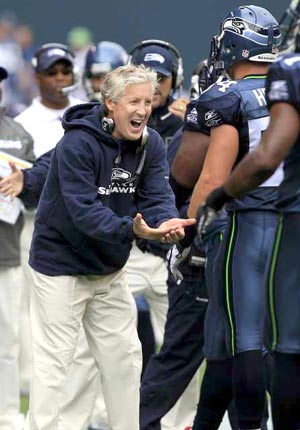I trust that you've read the last two entries (1, 2) regarding the importance of building a list of absolute, non-negotiable, principles or objectives that everyone in your organization knows and practices. I have received some feedback that I will share with you shortly, but I am hoping to get more ideas from you, the reader, before providing a list. Please refer to the above links to review exactly what I'm looking for in your list.
Briefly, the case was made that we can't rely on talent alone to achieve our business objectives. I used the Seattle Mariners to support this idea. Today, I'll present you with an excellent example of obsessing over the right things, this time using the Seattle Seahawks as an example.
The Seattle Seahawks are not predicted to return to the playoffs anytime soon. They have far too many new players and very few positions, if any, held by anyone who is considered the best at their position. Nonetheless, their record to date is two wins and two losses.
The reason for their relative success is fairly simple: Pete Carroll realizes that he can't match other teams, position for position. In fact, he realizes that having a team with so many new players and a lack of cohesion demands that he MUST boil down their objective to eliminate confusion and bring about a unified purpose... so that everyone GETS IT. So, instead of focusing on a complex set of principles, he has simplified the focus to one... Yes that's right, ONE objective:
"Offense= Don't give up the football; Defense= Get the football."
That's it. So, this entire year this Seahawks team will focus on their turnover ratio more than any other stat. Will they still make mistakes and turn over the football? Yes. Will they go to the playoffs? I don't know. But will they have a more favorable turnover ratio than their opponents? I believe they will. My hunch is that Pete Carroll knows that having small, attainable objectives can bring a team of new comrades together to build something great.
And by the way, remember....as I write this, they are 2-2 and challenging for the top of their division.
Have you simplified your objectives?
Editor's Note: This article was written by Dr. David Mashburn. Dave is a Clinical and Consulting Psychologist, Partner at Tidemark, Inc. and a regular contributor to WorkPuzzle. Comments or questions are welcome. If you're an email subscriber, reply to this WorkPuzzle email. If you read the blog directly from the web, you can click the "comments" link below.




Comments